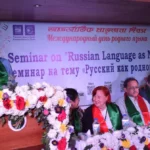In the grand chessboard of global geopolitics, the Indian Ocean has emerged as a queen, commanding respect and attention. The post-pandemic era has not only unveiled the resilience of South Asian nations but also spotlighted their potential in shaping the future world order. At the heart of this evolving narrative are India, an emerging superpower, and its neighbours, including the enchanting island nation of Sri Lanka. The dynamic interplay of these nations is not just a regional story but a chapter in the saga of global transformation.
The resilience of South Asia during the pandemic cannot be understated. As the world grappled with unprecedented challenges, this region showcased a remarkable spirit of solidarity. Communities, transcending national borders, came together, leveraging their shared cultural richness and inherent determination to overcome the trials and tribulations. This period, while riddled with hardships, was a testament to the indomitable spirit of its people, setting a stage for a future where South Asia could emerge as a powerhouse in global affairs.

India, an emerging superpower, and its neighbours, including Sri Lanka, have contributed to the dynamic interplay of global transformation. As the world grappled with unprecedented challenges, the South Asian region showcases a remarkable spirit of solidarity and leverage on their shared cultural richness and inherent determination to overcome the trials and tribulations.
The ascendancy of South Indians in the global arena as corporate leaders, politicians, sports stars, and artists is a narrative of this century. This emergence is not a sudden phenomenon but a crescendo of decades of cultural, educational, and economic progression. The technological cityscapes of Bangalore and Hyderabad, alongside the cinematic prowess of Chennai, epitomize a region that is no longer emerging but has indeed arrived.
However, the true strength of South Asia lies not merely in its economic prowess or geopolitical significance but in the unyielding spirit of its people. A region known for its diversity, South Asia is unified by an undying resilience. This is a land where adversities are not roadblocks but stepping stones to greater achievements. From the cricket fields, where once underdog teams now command global respect and admiration, to the political arenas where vibrant democracies narrate tales of human triumph and tenacity, the story of South Asia is one of an unstoppable force.
As we delve into the nuances of South Asia’s political landscape, its seemingly chaotic nature reveals a different kind of order. The diversity in political thought and governance models, while presenting challenges, also breeds robustness in the region’s economic and social fabric. This diversity is not a weakness but a testament to the dynamic and adaptable nature of its polities and economies.
In the realm of education, the region is witnessing a renaissance. Universities in South Asia are not just teaching centres but crucibles of innovation and thought leadership. The surge in online education has further democratized knowledge, allowing South Asian wisdom to reach every corner of the globe. This intellectual capital is the region’s most valuable asset in the global knowledge economy.
In the sphere of sports, particularly cricket, South Asia’s transformation is not merely a story of athletic prowess but a reflection of its societal and economic evolution. Once considered minnows, teams from India, Pakistan, Sri Lanka, and Bangladesh now command the cricketing world, much like the nations themselves rising on the world stage. The Indian Premier League (IPL) stands as a testament to India’s dominance, not just in the sport but in the larger arena of global entertainment and commerce. This is not merely a game; it is a narrative of regional empowerment and unity.
Amidst these stories of growth and progress, the economic liberalization of South Asian countries stands out as a bold declaration to the world. It signals readiness and hunger for business, innovation, and integration into the global economy. As these nations open their markets, they invite not just economic opportunity but cultural exchanges, fostering a more interconnected and understanding world.
Yet, the most powerful asset of South Asia remains its people. Two billion lives, each a thread in the rich tapestry of this region. The diverse yet shared experiences of these people are the fuel for South Asia’s engine of growth. In every challenge faced and every victory celebrated, it is the people of South Asia who have been the architects of their destiny. Their shared culture, beliefs, and actions speak louder than any policy or initiative. This is a region where blood runs thicker than water, where shared history and common futures intermingle to create a narrative of collective progress.
As we consider the future, particularly with India’s trajectory towards becoming the world’s third-largest economy, the implications for the region are profound. The growth of India is not an isolated event but a tide that lifts all boats in its wake. The interconnectedness of South Asian economies means that a thriving India can catalyze growth across the region. This is not just a story of one nation’s ascent but a tale of regional upliftment.
In conclusion, as we navigate the post-pandemic world, the role of South Asia, especially within the context of the Indian Ocean, is more critical than ever. The stories of its people, its nations, and its collective spirit form a mosaic of hope, resilience, and ambition. South Asia, with its dynamic economies, vibrant democracies, and unyielding spirit, is not just a region to watch but a region to engage with, learn from, and grow alongside. The future indeed shines brightly over the Indian Ocean, heralding the dawn of South Asia.
The question is, are we ready together?















